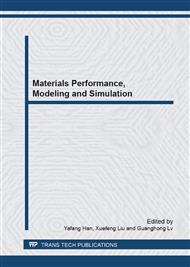[1]
F. Dohmann, C. Hartl, Hydroforming - a method to manufacture light-weight parts, J. Mater. Process. Technol. 60 (1996) 669-676.
DOI: 10.1016/0924-0136(96)02403-x
Google Scholar
[2]
M. Ahmetoglu, T. Altan, Tube hydroforming: state-of-the-art and future trends, J. Mater. Process. Technol. 98 (2000) 25-33.
DOI: 10.1016/s0924-0136(99)00302-7
Google Scholar
[3]
S.J. Yuan, C. Han, X.S. Wang, Hydroforming of automotive structural components with rectangular-sections, Int. J. Mach. Tool. Manu. 46 (2006) 1201-1206.
DOI: 10.1016/j.ijmachtools.2006.01.038
Google Scholar
[4]
S.H. Zhang, Developments in hydroforming, J. Mater. Process. Technol. 91 (1999) 236-244.
Google Scholar
[5]
T. Hama, T. Ohkubo, K. Kurisu, H. Fujimoto, H. Takuda, Formability of tube hydroforming under various loading paths, J. Mater. Process. Technol. 177 (2006) 676-679.
DOI: 10.1016/j.jmatprotec.2006.03.213
Google Scholar
[6]
M. Imaninejad, G. Subhash, A. Loukus, Loading path optimization of tube hydroforming process, Int. J. Mach. Tool. Manu. 45 (2005) 1504-1514.
DOI: 10.1016/j.ijmachtools.2005.01.029
Google Scholar
[7]
M. Loh-Mousavi, K. Mori, K. Hayashi, M. Bakhshi Jooybari, Improvement of filling of die corners in box-shaped tube hydroforming by control of wrinkling, Key Eng. Mater. 344 (2007) 461-467.
Google Scholar
[8]
K. Mori, T. Maeno, S. Maki, Mechanism of improvement of formability in pulsating hydroforming of tubes, Int. J. Mach. Tool. Manu. 47 (2007) 978-984.
DOI: 10.1016/j.ijmachtools.2006.07.006
Google Scholar
[9]
M. Loh-Mousavi, K. Mori, K. Hayashi, S. Maki, M. Bakhshi Jooybari, 3-D finite element simulation of pulsating T-shape hydroforming of tubes, Key Eng. Mater. 340-341 (2007) 353-358.
DOI: 10.4028/www.scientific.net/kem.340-341.353
Google Scholar
[10]
H.N. Han, C.G. Lee, D. -W. Suh, S. -J. Kim, A microstructure-based analysis for transformation induced plasticity and mechanically induced martensitic transformation, Mater. Sci. Eng. A. A 485 (2008) 224-233.
DOI: 10.1016/j.msea.2007.08.022
Google Scholar
[11]
F.D. Fischer, G. Reisner, E. Werner, K. Tanaka, G. Cailletaud, T. Antretter, A new view on transformation induced plasticity (TRIP), Int. J. Plasticity. 16 (2000) 723-748.
DOI: 10.1016/s0749-6419(99)00078-9
Google Scholar
[12]
M.R.D. Rocha, C.A.S.D. Oliveira, Evaluation of the martensitic transformations in austenitic stainless steels, Mater. Sci. Eng. A. A 517 (2009) 281-285.
DOI: 10.1016/j.msea.2009.04.004
Google Scholar
[13]
A.M. Beese, D. Mohr, Identification of the direction-dependency of the martensitic transformation in stainless steel using in situ magnetic permeability measurements, Exp Mech. 51 (2011) 667-676.
DOI: 10.1007/s11340-010-9374-y
Google Scholar
[14]
D. Raabe, Texture and microstructure evolution during cold rolling of a strip cast and of a hot rolled austenitic stainless steel, Acta Mater. 45 (1997) 1137-1115.
DOI: 10.1016/s1359-6454(96)00222-4
Google Scholar
[15]
S. Gallée, P. Pilvin, Deep drawing simulation of a metastable austenitic stainless steel using a two-phase model, J. Mater. Process. Technol. 210 (2010) 835-843.
DOI: 10.1016/j.jmatprotec.2010.01.008
Google Scholar
[16]
Y. Xu, S.H. Zhang, H.W. Song, M. Cheng, H.Q. Zhang, The enhancement of transformation induced plasticity effect on austenitic stainless steels by cyclic tensile loading and unloading, Mater. Lett. 65 (2011) 1545-1547.
DOI: 10.1016/j.matlet.2011.02.066
Google Scholar
[17]
Y. Xu, S.H. Zhang, H.W. Song, M. Cheng, In situ X-ray diffraction study of martensitic transformation in austenitic stainless steel during cyclic tensile loading and unloading, Scripta Mater. 67 (2012) 771–774.
DOI: 10.1016/j.scriptamat.2012.07.021
Google Scholar
[18]
M. Koc, Investigation of the effect of loading path and variation in material properties on robustness of the tube hydroforming process, J. Mater. Process. Technol. 133 (2003) 276-281.
DOI: 10.1016/s0924-0136(02)00849-x
Google Scholar
[19]
W.S. Park, S.W. Yoo, M.H. Kim, J.M. Lee, Strain-rate effects on the mechanical behavior of the AISI 300 series of austenitic stainless steel under cryogenic environments, Mater Design. 31 (2010) 3630-3640.
DOI: 10.1016/j.matdes.2010.02.041
Google Scholar


